INSTITUT SUPERIEUR D'ANTHROPOLOGIE
INSTITUTE OF ANTHROPOLOGY
ONLINE COURSES / COURS A DISTANCE
FALL TERM : OCTOBER 2013
REGISTER NOW
Rép.Tchèque – 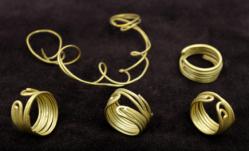
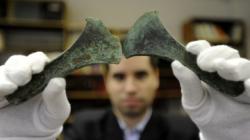 – Libochovany - A Czech dog walker has found a 4000-year-old treasure including gold and bronze jewels and tools at Libochovany in May and the items will go on display at the Teplice museum at the weekend, museum director Bohuslav Bocek has told journalists. Archaeologists say the find is unique. Only three similar ones were documented before. The bronze axes, jewels and gold hair decorations were probably unearthed by boars close to a tourist trail leading up a hill overlooking the Labe (Elbe) River valley. The dog walker picked up the rare objects and addressed Teplice archaeologists who returned to the spot the next day and found further smaller fragments of metals and ceramics. The metal items were probably placed in a ceramic vessel of which only two small fragments have survived to date.
– Libochovany - A Czech dog walker has found a 4000-year-old treasure including gold and bronze jewels and tools at Libochovany in May and the items will go on display at the Teplice museum at the weekend, museum director Bohuslav Bocek has told journalists. Archaeologists say the find is unique. Only three similar ones were documented before. The bronze axes, jewels and gold hair decorations were probably unearthed by boars close to a tourist trail leading up a hill overlooking the Labe (Elbe) River valley. The dog walker picked up the rare objects and addressed Teplice archaeologists who returned to the spot the next day and found further smaller fragments of metals and ceramics. The metal items were probably placed in a ceramic vessel of which only two small fragments have survived to date.
http://www.ceskenoviny.cz/news/zpravy/czech-dog-walker-finds-4000-year-old-gold-and-bronze-jewels/979777?
ROYAUME UNI – Gloucester - Archaeologists have discovered a headless and legless skeleton at the bottom of a well in the middle of a Roman cemetery. The gruesome find takes the skeleton tally up to 116 on the historical site off Brunswick Road in Gloucester. It seems the skeleton, believed to be of an adult male, was buried in the well and his limbs and skull decomposed long after his death. Site manager Stuart Joyce, from Cotswold Archaeology, said: "The skull was missing, as were the lower limbs. "The upper arms were also missing, but not the lower arms, which suggests the body parts decomposed after the body was buried. "The well dates from the first or second century, so it slightly predates the Roman cemetery surrounding it. "With the evidence on offer, we assume that the man died and then was buried, rather than anything else." Nothing else was found in the well in terms of artifacts, but the find remains of great interest nonetheless.
http://www.thisisgloucestershire.co.uk/Headless-skeleton-discovered-Roman-cemetery/story-19761085-detail/story.html#axzz2e2inr5Hq
TURQUIE –  Ilkadim - Six burials chambers were unearthed during the foundation excavation of a construction site in the Black Sea province of Samsun’s İlkadim district. Officials were informed about the findings and the first observations by the Samsun Archaeology and Ethnography Museum experts, who showed that the burial chambers were from the Hellenistic period. Among the findings are a gold eyewear, a couple of earrings, a metal hairpin, a metal anklet, two metal pieces of mirror and lots of earthen wares. Officials said the archaeological excavations would continue and the construction has been temporarily halted. They will decide on whether to continue excavations according to reports.
Ilkadim - Six burials chambers were unearthed during the foundation excavation of a construction site in the Black Sea province of Samsun’s İlkadim district. Officials were informed about the findings and the first observations by the Samsun Archaeology and Ethnography Museum experts, who showed that the burial chambers were from the Hellenistic period. Among the findings are a gold eyewear, a couple of earrings, a metal hairpin, a metal anklet, two metal pieces of mirror and lots of earthen wares. Officials said the archaeological excavations would continue and the construction has been temporarily halted. They will decide on whether to continue excavations according to reports.
http://www.hurriyetdailynews.com/ancient-pieces-found-in-black-sea-province-of-samsun.aspx?pageID=238&nID=53901&NewsCatID=375
TURQUIE – 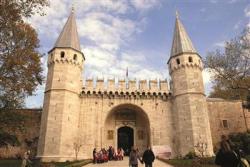 Istanbul - Topkapı Palace, regarded as the most important heritage site in Istanbul’s historic peninsula, has recently been enhanced with some new arrangements and renovations. The palace regained the Ottoman soul with the recent works that aimed to render the palace true to its original form. The pools of the palace, which were constructed in 1478 by Fatih Sultan Mehmet and served as the governmental center of the state and official residence of sultans for 380 years, were reactivated. Ten pools in the seraglio and garden of the palace are now operating following the works. Among these pools, the most important one is called “Selsebil” with 19 taps in the Privacy Chamber (Has Oda) of Murad III. That two prayer rooms in the seraglio of the palace were renovated to regain their original appearance and recovered by the museum is shown as a big progress. These prayer rooms, Karaağalar and Kadınlar, which served as depots after the palace became a museum, are set to open to visits within a month. The prayer rooms are expected to change the concept of seraglio in people’s minds. Also, tile panels with the Kaaba motif in the Karaağalr room are extremely precious elements of the museum’s tile collection. The Kadınlar room draws attention for a unique practice. Women accompany the community and imam behind a cage.
Istanbul - Topkapı Palace, regarded as the most important heritage site in Istanbul’s historic peninsula, has recently been enhanced with some new arrangements and renovations. The palace regained the Ottoman soul with the recent works that aimed to render the palace true to its original form. The pools of the palace, which were constructed in 1478 by Fatih Sultan Mehmet and served as the governmental center of the state and official residence of sultans for 380 years, were reactivated. Ten pools in the seraglio and garden of the palace are now operating following the works. Among these pools, the most important one is called “Selsebil” with 19 taps in the Privacy Chamber (Has Oda) of Murad III. That two prayer rooms in the seraglio of the palace were renovated to regain their original appearance and recovered by the museum is shown as a big progress. These prayer rooms, Karaağalar and Kadınlar, which served as depots after the palace became a museum, are set to open to visits within a month. The prayer rooms are expected to change the concept of seraglio in people’s minds. Also, tile panels with the Kaaba motif in the Karaağalr room are extremely precious elements of the museum’s tile collection. The Kadınlar room draws attention for a unique practice. Women accompany the community and imam behind a cage.
http://www.hurriyetdailynews.com/istanbuls-topkapi-palace-in-transformation.aspx?pageID=238&nID=53905&NewsCatID=375
BELIZE - A project to assist nine archaeological sites and their surrounding communities across Belize is moving forward with the delivery of an All Terrain Vehicle (ATV) last Friday at the Museum Building on Culvert Road, Belmopan. The project will improve the infrastructure and services at nine archaeological sites with a main focus in reducing poverty in rural areas. These targeted sites that will stand to benefit include Altun Ha in the Belize District, Lamanai in the Orange Walk District and Nim Li Punit, Blue Creek and Lubaantun in the Toledo District. Also to benefit from this Project will be Actun Tunichil Muknal, Barton Creek, the Nohoch Che’en (Cave’s Branch) and Xunantunich from the Cayo District.
http://www.guardian.bz/index.php?option=com_content&view=article&id=6742:nine-archaeological-sites-assisted&catid=40:politics&Itemid=90
ITALIE – 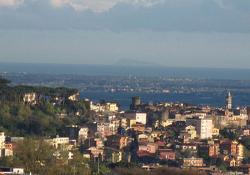 Castelli Romani - Police have foiled a group of looters raiding a yet unknown archaeological site near Rome, investigators said on Wednesday. The site is located near the ruins of a temple devoted to Juno ”The Saviour” at Lanuvio, in the Castelli Romani (Castles of Rome) – a cluster of towns southeast of Rome. Investigators reported that five marble architectural elements, coins, the ruins of a number of buildings and over 24,000 terracotta fragments attributable to the late Republican and Imperial period have been found. Investigators also found tools presumably being used for archeological theft, including metal detectors and two-way radios. The authorities commandeered 17,000 sq meters of farmland where the ruins of monumental walls were brought to light by the illegal excavation. Lazio regional authorities said the site and artifacts recovered were of great scientific interest due to the size of the discovery, the state of its preservation and the location, near an important Roman temple.
Castelli Romani - Police have foiled a group of looters raiding a yet unknown archaeological site near Rome, investigators said on Wednesday. The site is located near the ruins of a temple devoted to Juno ”The Saviour” at Lanuvio, in the Castelli Romani (Castles of Rome) – a cluster of towns southeast of Rome. Investigators reported that five marble architectural elements, coins, the ruins of a number of buildings and over 24,000 terracotta fragments attributable to the late Republican and Imperial period have been found. Investigators also found tools presumably being used for archeological theft, including metal detectors and two-way radios. The authorities commandeered 17,000 sq meters of farmland where the ruins of monumental walls were brought to light by the illegal excavation. Lazio regional authorities said the site and artifacts recovered were of great scientific interest due to the size of the discovery, the state of its preservation and the location, near an important Roman temple.
http://www.archaiologia.gr/en/blog/2013/09/06/castellini-romani-site-looted/
ROYAUME UNI – York - Archaeologists working for City of York Council may have found evidence of a medieval church in King’s Square. The team is working to transform the square, and also found the foundations of a Victorian church at the site during the dig. John Oxley, the council’s archaeologist, said: “Over the next couple of weeks the archaeologists will clean and record the remains of the church and remove any burials that might be affected by the resurfacing works. This is very exciting as opportunities, however brief, to look at these vanished churches in York are very rare.”
http://www.yorkpress.co.uk/news/10658973.Medieval_church_found_in_King___s_Square/?ref=rss
ROYAUME UNI – 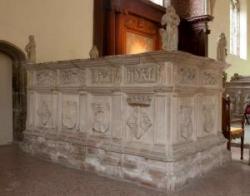 Norfolk - University of Leicester experts have tried to recreate two Tudor monuments using a mixture of humanities research and scientific technology. The experts have studied two tomb monuments which originally were intended to stand in Thetford Priory, Norfolk, in an exhibition at the Ancient House Museum, Thetford, Norfolk, from 7 September 2013 to 29 March 2014. The elaborate tombs were planned by Thomas Howard, 3rd Duke of Norfolk – one for himself, and another for Henry VIII’s illegitimate son, Henry Fitzroy, Duke of Richmond. The tombs were not complete when the priory was dissolved in 1540. Some parts of the monuments were salvaged and later finished off in a different style and with different materials, in St Michael's Church, Framlingham, Suffolk. Other parts were abandoned in the ruins of the priory and were discovered by excavators centuries later: those parts are now scattered in various museums - including the British Museum - and stores. The researchers have now brought together all these pieces, and used drawings in 16th century manuscripts, 3D laser scanning and 3D prints to recreate the monuments as they were originally intended.
Norfolk - University of Leicester experts have tried to recreate two Tudor monuments using a mixture of humanities research and scientific technology. The experts have studied two tomb monuments which originally were intended to stand in Thetford Priory, Norfolk, in an exhibition at the Ancient House Museum, Thetford, Norfolk, from 7 September 2013 to 29 March 2014. The elaborate tombs were planned by Thomas Howard, 3rd Duke of Norfolk – one for himself, and another for Henry VIII’s illegitimate son, Henry Fitzroy, Duke of Richmond. The tombs were not complete when the priory was dissolved in 1540. Some parts of the monuments were salvaged and later finished off in a different style and with different materials, in St Michael's Church, Framlingham, Suffolk. Other parts were abandoned in the ruins of the priory and were discovered by excavators centuries later: those parts are now scattered in various museums - including the British Museum - and stores. The researchers have now brought together all these pieces, and used drawings in 16th century manuscripts, 3D laser scanning and 3D prints to recreate the monuments as they were originally intended.
http://www.sciencedaily.com/releases/2013/09/130906101344.htm